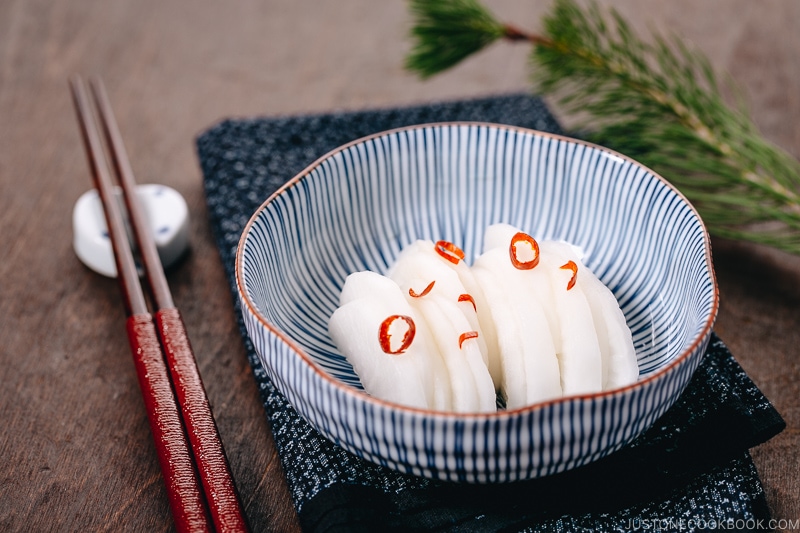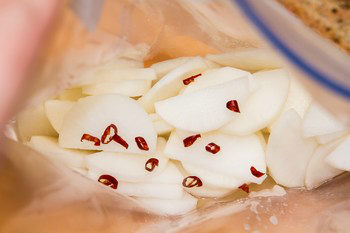Tangy and mildly sweet Japanese Pickled Daikon is an easy beginner‘s recipe that‘s ready in 2 hours. These pickles are a refreshing palate cleanser for traditional Japanese dishes or a condiment for Asian-style sandwiches and BBQ.

Root vegetables like daikon radishes are especially delicious in winter months, so let’s grab some daikon at your local Japanese or Asian grocery store and make this easy Japanese Pickled Daikon!
Table of Contents
Why You’ll Love This Recipe
- Quick and so easy to make! Ideal for beginners who are new to pickling vegetables.
- Extremely versatile. Not only does it complement Japanese meals, but the sweet and sour flavor also goes well with many Asian dishes. You could serve it with a rice meal or even as an accompaniment to your Asian-style pulled pork or meatball sandwiches.
- Ready in 2–3 hours. No long marination is needed.
- Stores well in the refrigerator for up to a month!
What is Daikon Radish?

Daikon (大根), also known as winter radish or Japanese radish, is a variety of large white radish used in Asian cooking. It is especially popular in Japanese cooking.
What does daikon taste like? It has a much milder flavor than regular red radishes. When eaten raw, it has a refreshing crunch and a light peppery taste. Once cooked, it gets tender, sweet, and really juicy. This makes it a great choice for soups, hot pots, and stews.
Why is daikon so healthy? In addition to its great flavor and versatility, daikon is known for its many health benefits and plays a big part in the nutritionally balanced meals in our culture. It is high in nutrients like vitamin C, calcium, magnesium, copper, and folate.
Eating pickled daikon has an added advantage as it offers an excellent source of probiotics that is good for your gut health.
How To Choose the Best Daikon
Daikon are extra juicy and have a milder taste during the cold winter months. However, daikon radishes are available all year round. Select a daikon that feels heavy and has a smooth skin. Look for a whole daikon that includes the green top, if possible.
The green leaves are the best part of this winter radish! I like to chop the leaves into small pieces and add them to Miso Soup or make Furikake (Japanese Rice Seasoning). So good!
One of the most popular ways to prepare daikon is to pickle it, like the recipe I shared here. Even the peppery daikon will mellow out nicely with a sweet and salty flavor when you pickle them. To remove the bitter and peppery taste of daikon, you can soak it in cold water.

Ingredients You’ll Need
- daikon radish
- rice vinegar – mild, slightly sweet, and delicate tasting and it’s most suited for Japanese and Asian cooking; I don’t recommend apple cider vinegar or another vinegar type for this recipe
- sake (Japanese rice wine) – optional
- salt and sugar – use a decent amount of both ingredients as the daikon releases lots of water while pickling
- dried red chili pepper – optional, but adds a spicy kick and color to the dish
How To Make Japanese Pickled Daikon
- Peel the daikon and cut into thin, half-moon slices.
- Cut the chili peppers into small pieces and discard the seeds if you prefer less spicy.
- Place all the ingredients in a resealable plastic bag and rub well to distribute the vinegar mixture. Remove the air before you seal the bag. You can start enjoying it after 2–3 hours! Store in the fridge for up to a month.
What To Serve with Pickled Daikon
This Japanese pickled daikon recipe is not meant to be eaten alone like a salad. We consider pickles as a palate cleanser between dishes and we call this kind of dish hashi yasume (箸休め, literally “chopstick” + “rest”).
I often serve this radish pickle as part of a traditional Japanese ichiju sansai (one soup, three dishes) meal, especially if the main dish is deep-fried. But you can also enjoy it with Instant Pot Asian pulled pork, BBQ Short Ribs, and Sticky Asian Ribs. They’d also be delicious added to banh mi sandwiches along with pickled carrots.

FAQs
Q: Can I make a double batch of this recipe?
For my recipe, I used only half the size of a large daikon. Please go ahead to make a double batch if you prefer to use up the entire daikon.
Q: Do I need to peel the daikon?
For Japanese cooking, we typically peel the skin as it can be rather thick.
Q: Can I use a jar to pickle the daikon?
You can use a ceramic or glass jar with weights instead of a resealable plastic bag. Just make sure the daikon is submerged in the pickle brine.
Q: My pickled daikon has a strong smell. Is this normal?
It’s true that daikon pickles develop a very strong and distinct odor. To manage this, I suggest that you store the pickles in a jar or container with a tightly sealing lid. This will help minimize the odor. While the pickles will keep in the refrigerator for up to a month, I recommend consuming the pickles sooner, as the odor gets stronger as time passes.
Q: How do I keep the pickles from getting too salty?
You can pour off the pickling liquid if you feel the flavor is becoming too strong or salty. Reseal the lid tightly and store in the refrigerator.
More Easy Pickles Recipes You’ll Like


In Japan, pickles, or what we call tsukemono (漬物), are a staple for Japanese meals. They are usually served with rice and considered as a necessary accompaniment to Japanese meals. Here are more pickle recipes you’ll love:
- Easy Pickled Daikon and Carrot with Sweet Vinegar
- Pickled Sushi Ginger (Gari)
- Japanese Pickled Cabbage
- Pickled Cucumber

Wish to learn more about Japanese cooking? Sign up for our free newsletter to receive cooking tips & recipe updates! And stay in touch with me on Facebook, Pinterest, YouTube, and Instagram.

Pickled Daikon
Ingredients
- 1 lb daikon radish (about half a large daikon per batch)
- 1 dried red chili pepper
- 2 Tbsp rice vinegar (unseasoned)
- 1 tsp sake (optional)
- 1 Tbsp Diamond Crystal kosher salt
- ⅓ cup sugar
Instructions
- Before You Start…Please note that this recipe requires 2–3 hours of pickling time. Gather all the ingredients.

- Peel 1 lb daikon radish and cut it in half lengthwise. Then, cut it crosswise into half-moon slices about ¼ inch (6 mm) thick.

- Cut 1 dried red chili pepper crosswise into small pieces. Discard the seeds if you prefer it less spicy.

- Put the daikon, chili pepper, 2 Tbsp rice vinegar (unseasoned), 1 tsp sake, 1 Tbsp Diamond Crystal kosher salt, and ⅓ cup sugarin a resealable bag. Rub well from outside the bag to distribute the seasonings. Alternatively, you can use a ceramic or glass jar with weights.

- Remove the air from the bag and seal it. Let it rest for 2–3 hours in the refrigerator. Remove from the pickling solution and enjoy!

To Store
- Transfer the pickles to an airtight container and store in the refrigerator for up to a month. However, I recommend consuming them sooner, as the odor gets stronger as time passes. To minimize the odor, use a jar or container with a tightly sealing lid. When the flavor gets too salty and strong, pour off the pickling liquid and reseal the lid.









How much would be a third “cup”? I guess this is a thing in the US, but I have no clue at all…
Hi Alex! Thank you for trying Nami’s recipe!
1/3 US cup is about 79 ml, and we used around 67g of sugar. Feel free to tweak the sweetness to your taste whatever works best for you! Hope that helps!
Hi!
Love this and will definitely make some to try out. My partner loves takuan and I would love to try making some at home this winter (NZ). Would love it if you could post a recipe for homemade takuan!
Hi, Marita! Thank you for reading Nami’s post and trying her recipe!
Thank you for your recipe request. We’ll be sure to include it on the wish list! 🙂
Is it possible to substitute the sake or can I leave it out?
Hi Marissa! Thank you so much for trying Nami’s recipe!
Sake is optional, so you can leave it out. Enjoy!
They taste good. I used tabl. Salt. But much less to compensate for saltiness. It came out good and now I have a new healthy snack.
Hi Victoria! We are glad to hear you enjoyed Nami’s recipe!
Thank you so much for your kind feedback. 🤗
I did mine 2 hrs ago tasted it and it’s so salty what am I doing wrong
Hello, Brooke! Have you tried the same amount of Daikon for this recipe? If you follow the directions and it still tastes salty to you, we apologize!
Next time, either adjust the salt amount or minimize the pickling time.
Thank you for trying Nami’s recipe.
If you’re not using Diamond Crystal salt you’re going to need to adjust the volume. Using Morton’s or regular table salt at the same volume will be way saltier
Hi, Brooke! Eric has a good point! If you use table salt, you will need half of the amount recommended in the recipe.
You may learn more about Diamond Crystal salt on this page.🙂
https://www.justonecookbook.com/diamond-crystal-kosher-salt/